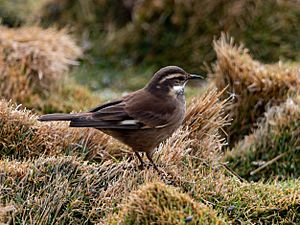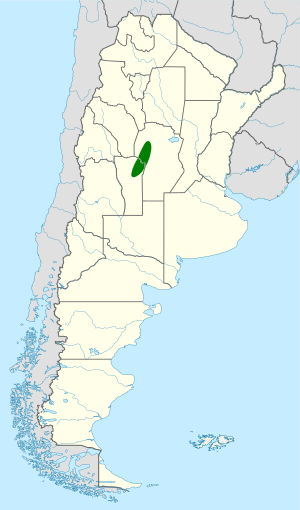Olrog's cinclodes facts for kids
Quick facts for kids Olrog's cinclodes |
|
|---|---|
 |
|
| Conservation status | |
| Scientific classification | |
| Genus: |
Cinclodes
|
| Species: |
olrogi
|
 |
|
The Olrog's cinclodes (Cinclodes olrogi) is a special type of bird that belongs to the Furnariidae family. This bird is found only in Argentina, which means it is endemic to that country. It was named after a famous Swedish-Argentine scientist named Claes C. Olrog.
This bird lives in places with lots of shrubland at high altitudes, where the weather can be subtropical or tropical. You can find it in a small area of Argentina, stretching from San Luis up to the northern parts of Córdoba.
Contents
About Olrog's Cinclodes
Olrog's cinclodes is a small bird, usually around 16 to 17 centimeters long. It has a mostly brown body with lighter stripes on its throat and chest. Its wings often show a reddish-brown patch, and it has a pale stripe above its eye. These birds are known for their strong legs and feet, which help them move around rocky areas.
Where Does It Live?
Olrog's cinclodes prefers to live in high mountain areas. Its home is typically found at elevations between 1,600 and 2,800 meters (about 5,200 to 9,200 feet) above sea level. It likes rocky slopes, grasslands, and areas with low shrubs. These birds are often seen near streams or small rivers in these mountain habitats.
Its Special Habitat
The specific places where Olrog's cinclodes lives are often called "high-altitude shrubland." This means it's a type of land found high up in the mountains, covered with bushes and small plants. This bird is very particular about its home, which is why it's only found in a narrow strip of land in Argentina.
What Does It Eat?
Olrog's cinclodes mainly eats small invertebrates. These include insects like beetles, ants, and spiders. It finds its food by searching among rocks, in cracks, and under plants. It uses its beak to probe and pick up tiny creatures from the ground.
Foraging Habits
These birds are often seen hopping along the ground or on rocks, looking for their next meal. They are quite active and spend a lot of time searching for food in their mountain homes. Their diet helps control insect populations in their natural habitat.
Life and Habits
Olrog's cinclodes is a shy bird that usually lives alone or in pairs. They are known for their quick movements and their ability to blend into their rocky surroundings. When they fly, their flight is often short and close to the ground.
Sounds and Calls
Like many birds, Olrog's cinclodes uses different sounds to communicate. They have a distinct call that helps them find each other or warn others about danger. Their songs are often simple but can be heard across their mountain territories.
Reproduction and Life Cycle
Not much is known about the exact details of the Olrog's cinclodes' reproduction. However, like other cinclodes species, they likely build their nests in crevices or holes among rocks. The female bird lays eggs, and both parents probably help to raise the young. The breeding season usually happens during the warmer months when food is plentiful.
Raising Young Birds
Once the chicks hatch, they are cared for by their parents until they are strong enough to fly and find their own food. This period is very important for the survival of the young birds, as they learn how to forage and avoid predators in their mountain environment.
Conservation Status
The Olrog's cinclodes is currently listed as "Least Concern" by the International Union for Conservation of Nature (IUCN). This means that its population is stable and not currently facing major threats. However, because it lives in a very specific and narrow habitat, it's important to keep an eye on its environment to make sure it stays safe.
Protecting Its Home
Even though it's not endangered, protecting the high-altitude shrubland where Olrog's cinclodes lives is important. Changes to its habitat, like human development or climate change, could affect its population in the future. Conservation efforts help ensure that this unique bird continues to thrive in Argentina.
See also
 In Spanish: Remolinera de Olrog para niños
In Spanish: Remolinera de Olrog para niños


